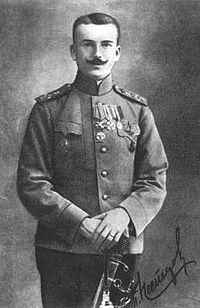- Pyotr Nesterov
-
Pyotr Nikolayevich Nesterov
Пётр Николаевич Нестеров
Born February 15, 1887
Nizhny NovgorodDied September 8, 1914 (aged 27)
Zhovkva, Lviv OblastAllegiance Russian Empire Service/branch Imperial Russian Army Years of service 1906—1914 Rank Stabskapitan Battles/wars First World War Pyotr Nikolayevich Nesterov (Russian: Пётр Николаевич Нестеров) (27 February [O.S. 15 February] 1887 in Nizhny Novgorod - 8 September [O.S. 26 August] 1914 in Zhovkva, Lviv Oblast) was a Russian pilot, an aircraft technical designer and an aerobatics pioneer.
Contents
Life and career
The son of a military academy teacher, Pyotr Nesterov decided to choose a military career. In August 1904 he left the military school in Nizhny Novgorod and went to the artillery school, considered one of the best of its kind. He became a second lieutenant and served in the 9th East Siberian artillery brigade in Vladivostok. In 1909, he came into contact with aviation when he was sent to an aircraft manufacturer to work. He built his first glider and learned to fly it.
In 1911 Nesterov began formal training as a pilot and graduated on 11 October 1912. A short time later he also passed the examination to be a military pilot. In May 1913 he became leader of a relay in Kiev, completing night flights at that time.
Achievements
Nesterov believed an aircraft could fly a loop, a feat not previously performed. Despite the doubts of his peers, Nesterov proved his theory on 9 September 1913 (27 August by the calendar then used in Russia) and became the first pilot to fly a loop. This was done in a Nieuport IV monoplane with a 70 hp Gnome engine over Syretzk Aerodrome near Kiev, before many watchers. For this he was disciplined with ten days of close arrest, ostensibly "for risking government property". His achievement made him famous overnight and the punishment was reversed; he was promoted to staff captain and later awarded a medal. He founded the practice of aerobatics, stressing the value of these exercises for a military pilot. Nesterov improved the flight methods and designed new flight models without rudders.
The First World War gave Nesterov the opportunity to test his air war theories in practice. He was particularly adept at controlling the bomb release.
Aircraft were unarmed at this early stage, and Nesterov became the first pilot to destroy an enemy airplane in flight in the history of military aviation. On 25 August 1914, using a Morane-Saulnier Type G monoplane (s/n 281), he rammed an Austrian reconnaissance plane Albatros B.II of Observer Baron Friedrich von Rosenthal and pilot Franz Malina from FLIK 11 after firing unsuccessfully at them with a pistol.[1] Eager to destroy enemy aircraft, he probably intended to hit it with a landing gear of his Morane-Saulnier monoplane, but he hit it with his plane's propeller instead. As a result, both planes crashed. Nesterov, who had not strapped himself in, fell from his plane to his death.[2] The Austrian pilot and Observer also died.[3][4] The town of Zhovkva (currently in Lviv Oblast, Ukraine) near the famous air fight was renamed Nesterov in 1951, though it has since reverted to Zhovkva.
Legacy
Nesterov was buried in Kiev, Ukraine. His ramming method was used during the Second World War by a number of Soviet pilots with success and without their loss of life. The air-combat technique of ramming Nesterov pioneered became known in Russian as "Taran". In honor of Nesterov the Soviet Union established the Nesterov's cup for the best aerobatics crew. The cup was donated to the International Aeronautics Federation in 1962. It is awarded to the Men's World Team Champions of the World Aerobatic Championships.[5]
A minor planet 3071 Nesterov discovered by Soviet astronomer Tamara Mikhailovna Smirnova in 1973 is named after him.[6]People and aircraft Campaigns and battles Strategic bombing (German, Cuxhaven) · Bombing of cities · Fokker Scourge · Flight over Vienna · Bloody April · BattlesEntente Powers air services Australian Flying Corps · British air services (Royal Flying Corps, Royal Naval Air Service, Royal Air Force) · French Air Service · Imperial Russian Air Force · Italian Military Air Corps · United States Army Air Service · Greek air services (Army Air Service, Naval Air Service)Central Powers air services German air services (Army Air Service, Navy Air Service) · Austro-Hungarian Imperial and Royal Aviation Troops · Ottoman Air Force · Bulgarian Army Aeroplane SectionSee also
- Aerial ramming
References
- Annette Carson - Flight Fantastic: The Illustrated History of Aerobatics (1986)
- Jon Guttman, et al. Pusher Aces of World War 1. Osprey Pub Co, 2009. ISBN 1846034175, 9781846034176.
Sources of information
- ^ Pusher Aces of World War 1.. p. 9.
- ^ From Tsarist General to Red Army Commander by Mikhail Bonch-Bruyevich, translated by Vladimir Vezey, Progress Publishers, 1966, p30
- ^ Pyotr Nesterov - Great War Forum at 1914-1918.invisionzone.com
- ^ First recorded meeting in the air? - Great War Forum at 1914-1918.invisionzone.com
- ^ AIR SPORTS INTERNATIONAL at airsports.fai.org
- ^ . http://books.google.com/books?hl=ru&q=3067+akhmatova+1982.
External links
- Biography of Pyotr Nesterov - in Russian
Categories:- 1887 births
- 1914 deaths
- Russian aviators
- Aerial warfare pioneers
- Russian inventors
- Aviators killed in aviation accidents or incidents
- Imperial Russian Air Force personnel
- Aerobatic pilots
- Recipients of the Order of Saint George IV Class
Wikimedia Foundation. 2010.



